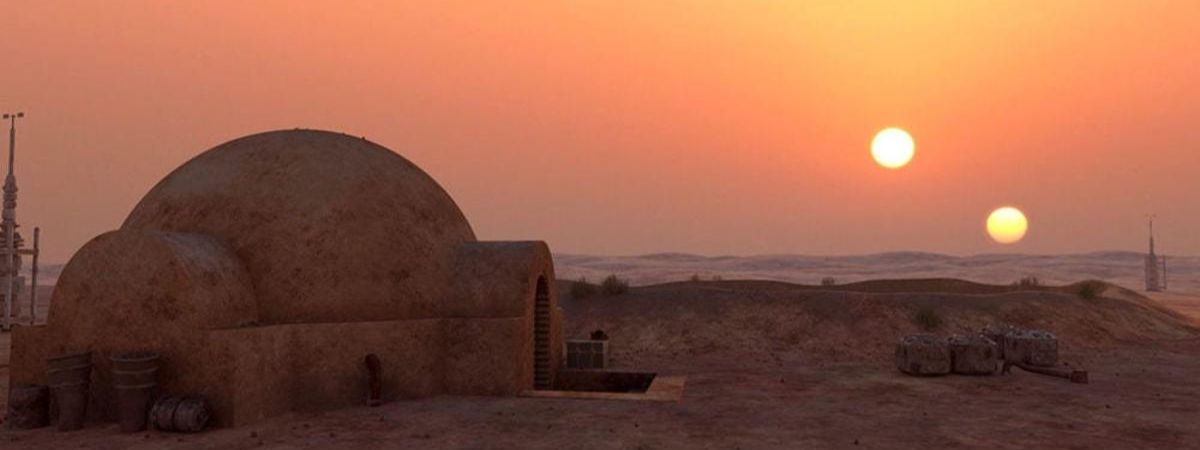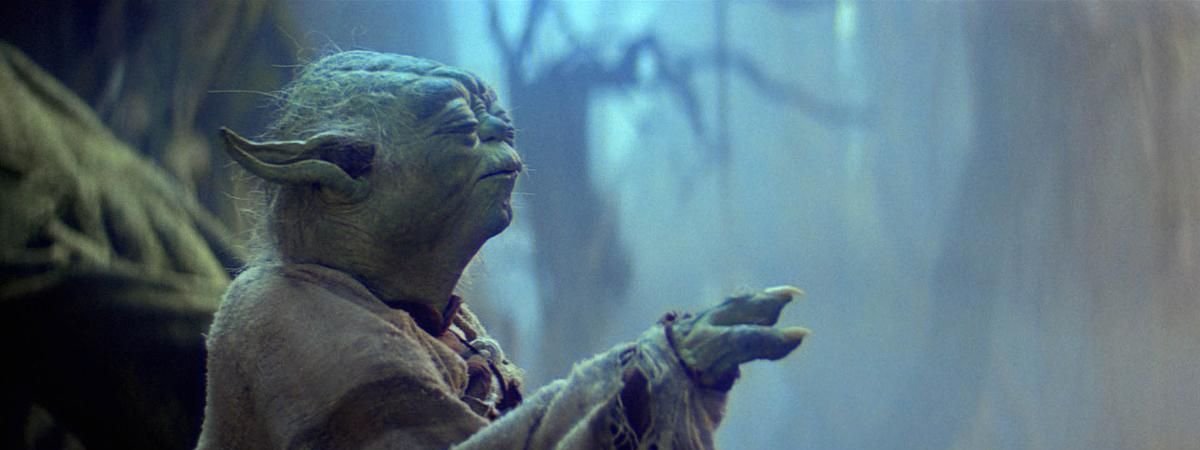Embark on a galactic journey through the Star Wars universe as we explore the iconic planets that have not only shaped the Star Wars timeline but also showcased groundbreaking special effects. From the desert landscapes of Tatooine to the lush forests of Endor, each planet tells a story of conflict, survival, and destiny.
Ahch-To
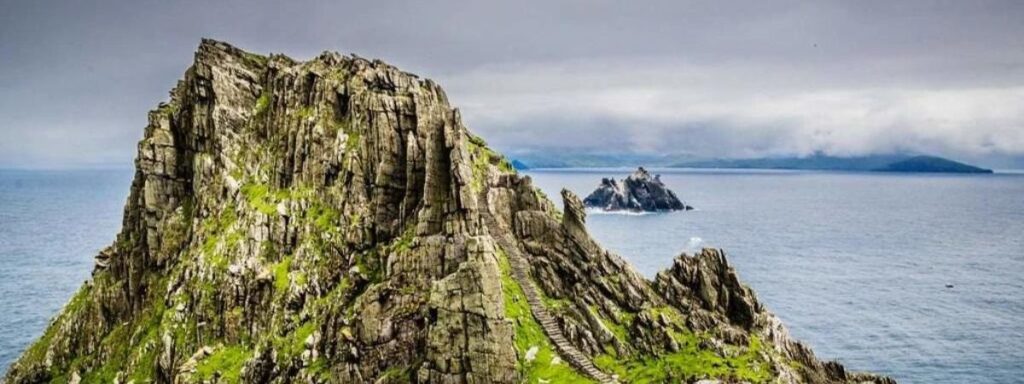
Famous for:
- The site of the first Jedi Temple.
- The secluded refuge of Luke Skywalker.
Appeared in:
- “Star Wars: Episode VII – The Force Awakens” (briefly, in the final scene)
- “Star Wars: Episode VIII – The Last Jedi”
Ahch-To is characterized by rugged landscapes, with rocky islands scattered across vast oceans. Its solemn and mystic ambiance fits the ancient wisdom of the first Jedi Temple. Luke Skywalker’s island is marked by ancient stone structures, surrounded by wild seas that highlight his refuge’s isolation and spiritual significance. The planet is uninhabited except for native Porgs and the ancient Caretakers. Ahch-To’s introduction adds depth to the Jedi Order’s lore, symbolizing themes of solitude, meditation, and a return to roots central to the Jedi way of life.
Ajan Kloss

Famous for:
- Serving as a base for the Resistance in the “Star Wars” sequel trilogy.
Appeared in:
- “Star Wars: Episode IX – The Rise of Skywalker”
Ajan Kloss, a verdant, jungle-covered planet, was chosen by the Resistance for its remote location, making it an ideal hideaway from the First Order. Dense forests and ancient ruins from the native species provide a backdrop filled with natural beauty and history. This planet played a pivotal role as a strategic point for the Resistance’s final stand against the First Order, embodying the themes of hope and resilience in the face of overwhelming odds.
Alderaan

Famous for:
- Princess Leia’s homeworld.
- Its destruction by the Death Star in a show of Imperial power.
Appeared in:
- “Star Wars: Episode IV – A New Hope”
Alderaan was known for its peaceful landscapes, mountain ranges, and serene beauty, making its destruction one of the most tragic events in the “Star Wars” saga. Before its annihilation, it was celebrated as a center for diplomacy, art, and culture. The planet’s obliteration marks a pivotal moment in the Galactic Civil War, highlighting the ruthless nature of the Empire and galvanizing support for the Rebel Alliance.
Aldhani
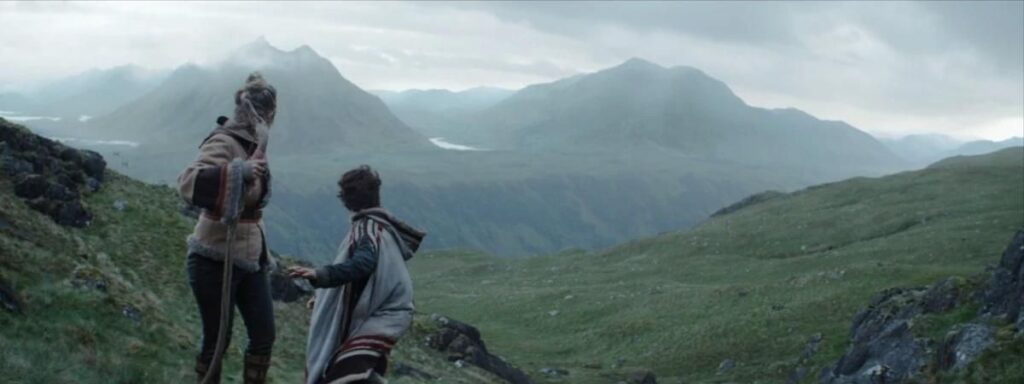
Famous for:
- Featured in the series “Andor” as the location of a daring heist by Cassian Andor and his team.
Appeared in:
- “Andor”
Aldhani is characterized by its striking landscapes and harsh climates, which range from snowy peaks to rugged terrains. This planet is relatively unknown in the broader “Star Wars” galaxy, gaining notoriety mainly through the audacious heist against the Empire, showcasing themes of resistance and the fight for freedom.
Batuu
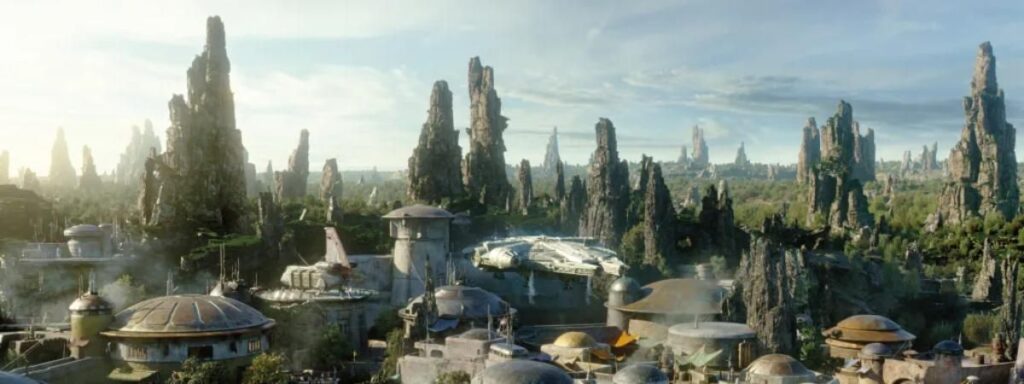
Famous for:
- Edge of the galaxy location.
- The setting for the theme park Star Wars: Galaxy’s Edge.
Appeared in:
- “Star Wars: Galaxy’s Edge” theme park attraction
Batuu is a frontier planet on the galaxy’s edge, known for Black Spire Outpost, a bustling hub for traders, adventurers, and smugglers traveling around the Outer Rim and Wild Space. Its presence in the theme park allows fans to experience the “Star Wars” universe firsthand, blending immersive storytelling with real-world exploration. Batuu’s narrative significance is enhanced by its depiction as a crossroads for various characters in the saga, reflecting the diverse and dynamic nature of the “Star Wars” universe.
Bespin

Famous for:
- The gas giant with the floating city, Cloud City.
- Scene of the dramatic duel between Luke Skywalker and Darth Vader.
Appeared in:
- “Star Wars: Episode V – The Empire Strikes Back”
Bespin is best known for its Cloud City, a mining colony floating in the upper atmosphere that harvests atmospheric gases. The city became infamous as the site of numerous pivotal moments in the “Star Wars” saga, including Lando Calrissian’s betrayal of Han Solo and the revelation of Luke Skywalker’s parentage. Bespin’s ambiance is a mix of luxury and intrigue, reflecting its role as a haven for smugglers, gamblers, and those seeking to avoid the prying eyes of the Galactic Empire.
Cato Neimoidia
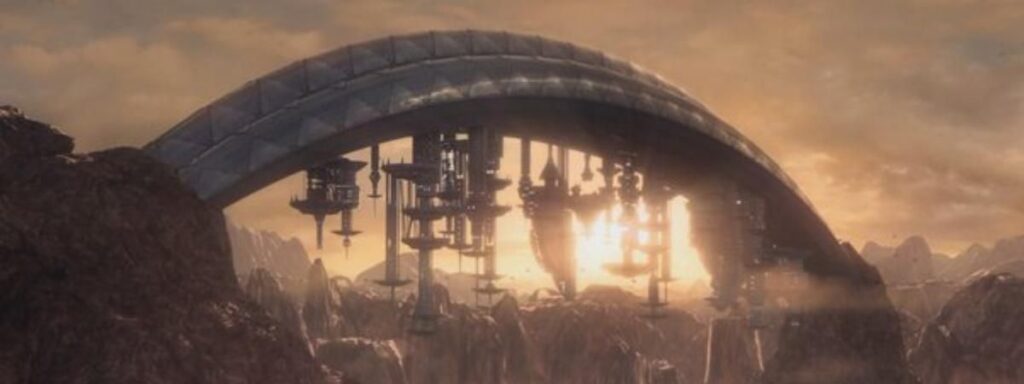
Famous for:
- Its wealthy cities, suspended from large bridges.
- Ties to the Trade Federation leadership.
Appeared in:
- “Star Wars: Episode III – Revenge of the Sith”
Cato Neimoidia, known for its opulent cities that hang beneath vast archways, served as a stronghold for the Trade Federation’s Neimoidian leadership. This planet’s architectural marvels and significant wealth underscore its economic and political importance within the “Star Wars” universe. Cato Neimoidia was also a battleground during the Clone Wars, reflecting its strategic and material value.
Corellia
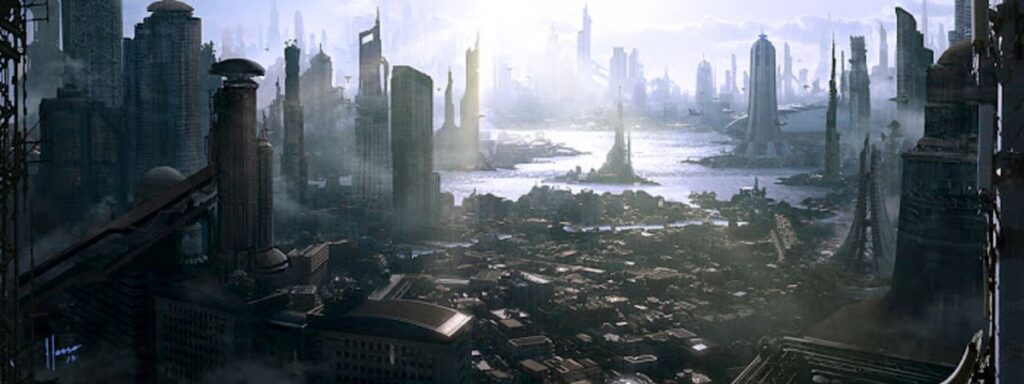
Famous for:
- Birthplace of Han Solo.
- Known for its shipyards that produce some of the galaxy’s fastest ships, including the Millennium Falcon.
Appeared in:
- “Solo: A Star Wars Story”
Corellia is an industrial planet renowned for its shipbuilding, contributing to its gritty, mechanical landscape. As the birthplace of Han Solo, Corellia is critical to the “Star Wars” narrative, exemplifying themes of escape and the search for freedom. Its shipyards are some of the most capable in the galaxy, creating vessels that play key roles in numerous galactic conflicts.
Coruscant
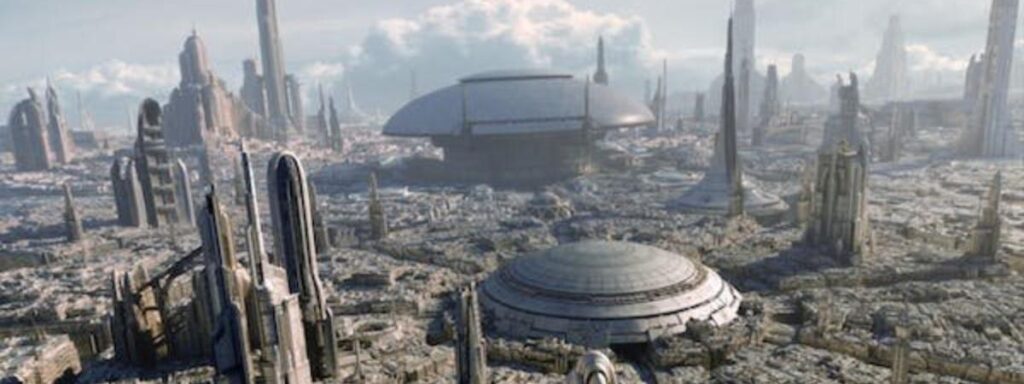
Famous for:
- The capital of the Galactic Republic and later the Empire.
- Its planet-wide cityscape.
Appeared in:
- “Star Wars: Episode I – The Phantom Menace”
- “Star Wars: Episode II – Attack of the Clones”
- “Star Wars: Episode III – Revenge of the Sith”
Coruscant is the bustling, cosmopolitan heart of the galaxy, serving as the political hub throughout much of the “Star Wars” series. Its surface is completely covered by a city with towering skyscrapers, shining aeries, and shadowy underworlds. The planet is significant as the site of major political events, including debates, coups, and the transition from Republic to Imperial rule, making it central to understanding the political dynamics of the “Star Wars” universe
Crait

Famous for:
- Its abandoned Rebel base.
- The site of the Resistance’s last stand against the First Order in “The Last Jedi.”
Appeared in:
- “Star Wars: Episode VIII – The Last Jedi”
Crait, a small, desolate planet covered with white salt over its red soil, becomes a battlefield in a desperate and visually striking last stand of the Resistance. The contrast of red against the white landscape, especially during the battle scenes, symbolizes the bloodshed and the stark nature of their struggle for survival against overwhelming odds.
Dagobah
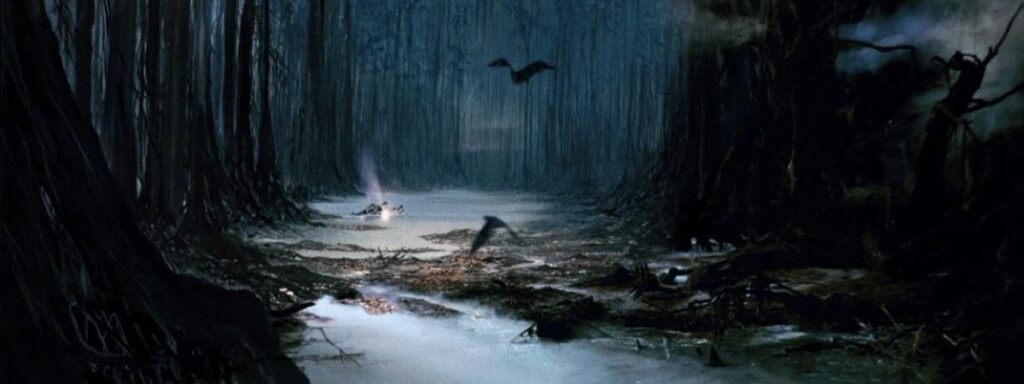
Famous for:
- Yoda’s refuge during his exile.
- The place where Luke Skywalker trains under Yoda.
Appeared in:
- “Star Wars: Episode V – The Empire Strikes Back”
- “Star Wars: Episode VI – Return of the Jedi”
Dagobah is a swamp-covered planet teeming with life yet isolated from the broader galaxy. It serves as a spiritual hub for Luke Skywalker’s transformative Jedi training under Master Yoda, emphasizing themes of growth and introspection away from technological and political disturbances.
Dantooine
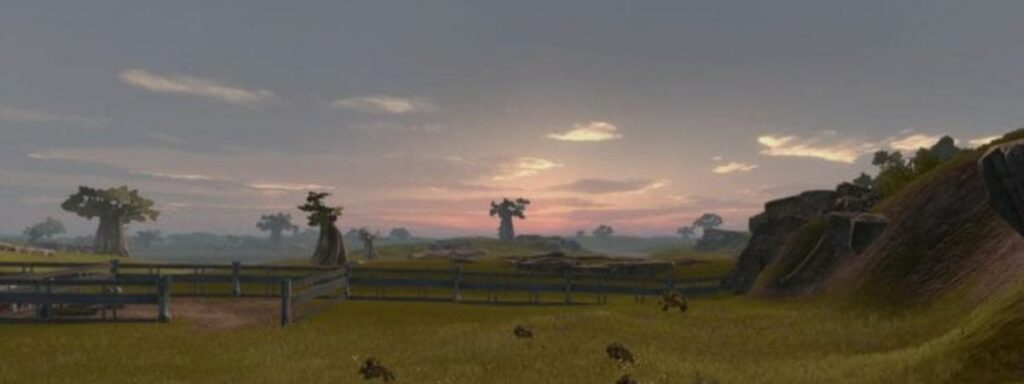
Famous for:
- Its mention as a former Rebel base in “A New Hope.”
Appeared in:
- “Star Wars: Episode IV – A New Hope” (mentioned)
Dantooine is a remote, rural planet that once housed a Rebel Alliance base used in the early stages of their fight against the Galactic Empire. While its strategic use by the Rebels is primarily mentioned rather than shown, it marks it as a symbol of the early resistance efforts.
Dathomir
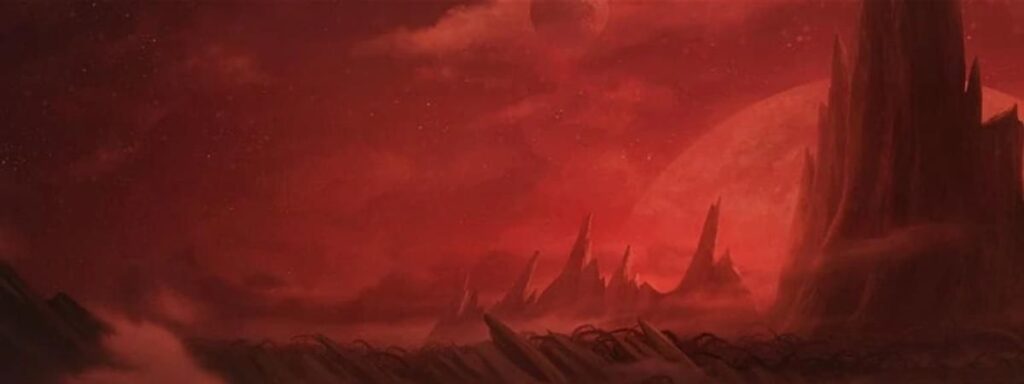
Famous for:
- The homeworld of the Nightsisters, including Asajj Ventress.
- Maul’s place of origin.
Appeared in:
- “Star Wars: The Clone Wars” animated series
Dathomir is a dark, foreboding planet known for its strong associations with the dark side of the Force, particularly through the witchcraft of the Nightsisters. It plays a crucial role in the backstory of significant characters like Darth Maul and Asajj Ventress, adding a layer of mysticism and primal force lore to the “Star Wars” saga.
D’Qar
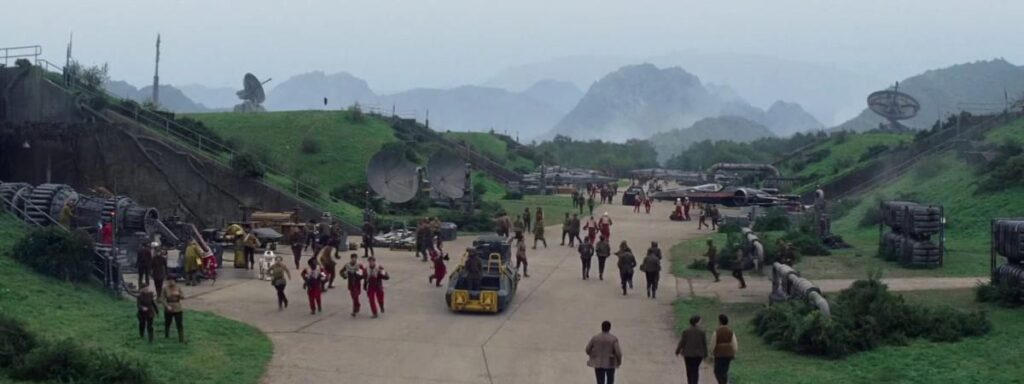
Famous for:
- The location of the Resistance’s primary base before its evacuation.
Appeared in:
- “Star Wars: Episode VII – The Force Awakens”
- “Star Wars: Episode VIII – The Last Jedi”
D’Qar is a lush, forested planet that housed the main base of operations for the Resistance. This base plays a key role in planning and launching operations against the First Order, serving as a fleeting sanctuary amid escalating conflicts across the galaxy.
Endor
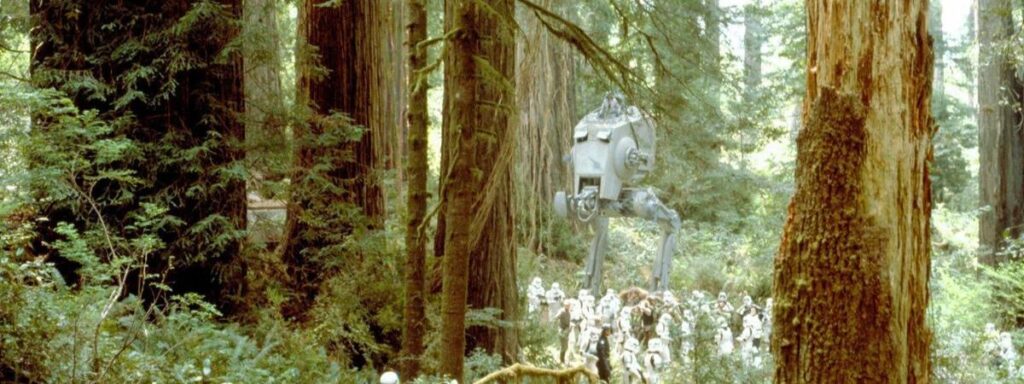
Famous for:
- Being the site of the second Death Star’s shield generator.
- The Ewoks, a native species that played a pivotal role in the Battle of Endor.
Appeared in:
- “Star Wars: Episode VI – Return of the Jedi”
Endor, also known as the Forest Moon of Endor, is lush and teeming with life, featuring dense forests and various creatures. It’s renowned for the decisive Battle of Endor, where the Rebel Alliance, aided by the Ewoks, defeated the Galactic Empire, destroying the second Death Star.
Exegol
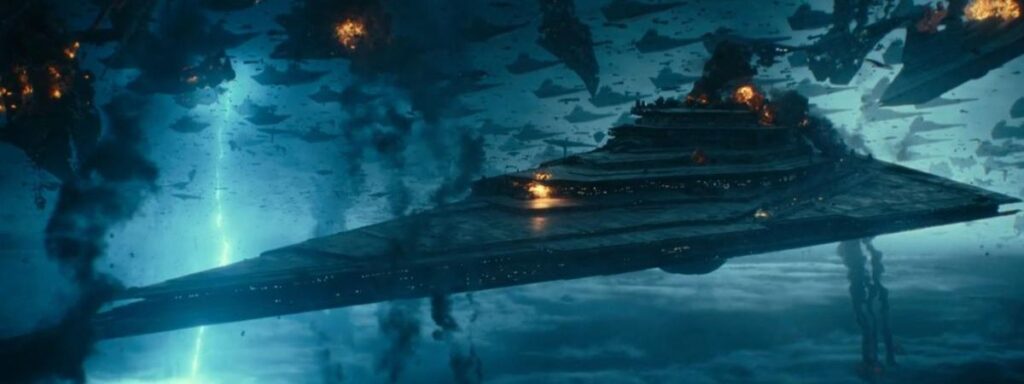
Famous for:
- The hidden Sith planet in the Unknown Regions.
- The site of the final battle in “The Rise of Skywalker.”
Appeared in:
- “Star Wars: Episode IX – The Rise of Skywalker”
Exegol is a dark, barren planet shrouded in mystery, serving as a secret stronghold of the Sith. Its foreboding atmosphere and ancient Sith artifacts set the stage for the climactic confrontation between good and evil forces, marking the Skywalker saga’s end.
Felucia

Famous for:
- Its lush, jungle-filled landscapes that are as dangerous as they are beautiful.
- The site of a major battle during the Clone Wars.
Appeared in:
- “Star Wars: Episode III – Revenge of the Sith”
Felucia is a vibrant but deadly world, filled with fungal growths and immense flora and fauna. It represents the wild, untamed beauty of nature within the galaxy, and was a battleground where Jedi Knight Aayla Secura met her tragic fate during Order 66.
Ferrix
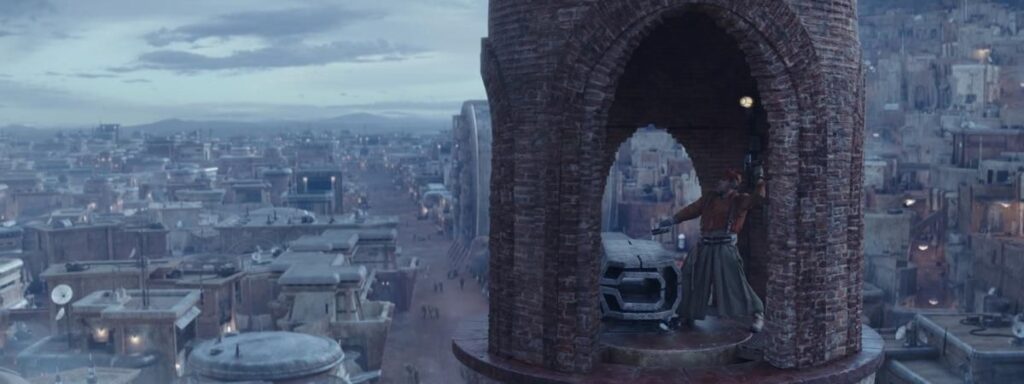
Famous for:
- A gritty, industrial world featured in the “Andor” series.
Appeared in:
- “Andor”
Ferrix is a lesser-known, working-class planet with a strong sense of community among its inhabitants. Its dusty, mechanical landscapes serve as a backdrop for the grassroots rebellion movements that gain momentum throughout the “Andor” series, emphasizing themes of resistance and subversion.
Geonosis

Famous for:
- The site of the first battle of the Clone Wars.
- The Geonosians, native insectoid species known for their massive hive structures.
Appeared in:
- “Star Wars: Episode II – Attack of the Clones”
Geonosis is pivotal in galactic history as the arena where the Clone Wars erupted. Its arid, rocky environment and immense battle droid foundries highlight the industrial might of the Separatists, setting the stage for the widespread conflict that would engulf the galaxy.
Hoth

Famous for:
- The icy, snow-covered terrain.
- The location of the Rebel Alliance’s Echo Base.
- The site of the Battle of Hoth, a major confrontation in “The Empire Strikes Back.”
Appeared in:
- “Star Wars: Episode V – The Empire Strikes Back”
Hoth is an inhospitable, frozen wasteland known for its frigid climate and native fauna like the predatory Wampa and the hardy Tauntauns. The planet is most notable for the Battle of Hoth, where the Rebel Alliance momentarily held off the advancing Imperial forces by using the harsh environment to their advantage.
Ilum

Famous for:
- A sacred site for Jedi, rich in Kyber crystals used to power lightsabers.
- Its transformation into Starkiller Base by the First Order.
Appeared in:
- “Star Wars: The Clone Wars” animated series
- Mentioned in context with Starkiller Base in “Star Wars: Episode VII – The Force Awakens”
Ilum holds a special place in Jedi lore, primarily serving as the site where young Jedi initiates would come to find the Kyber crystals essential for building their lightsabers. This icy planet’s spiritual significance contrasts sharply with its later conversion into Starkiller Base, representing a perversion of a sacred site into a weapon of massive destruction.
Jakku
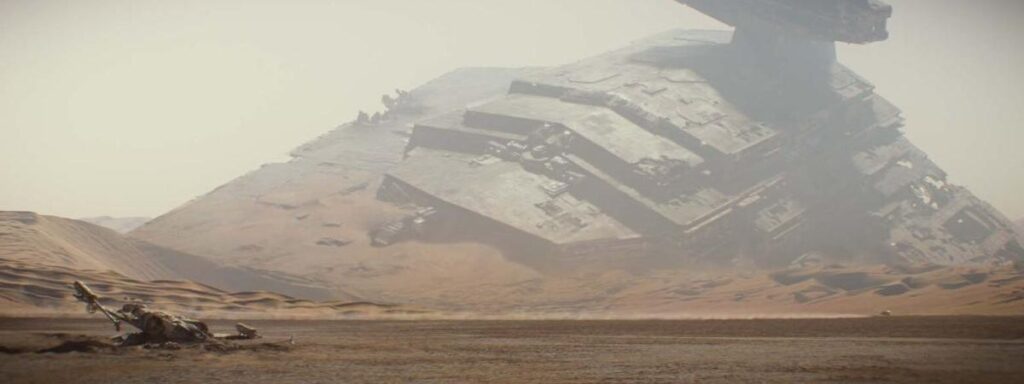
Famous for:
- Being a remote desert planet where Rey is first introduced.
- The site of a pivotal battle, the Battle of Jakku, marking the end of the Galactic Civil War.
Appeared in:
- “Star Wars: Episode VII – The Force Awakens”
Jakku is a stark desert world littered with the wreckage of starships from the final battle between the New Republic and the remnants of the Empire. It symbolizes abandonment and desolation but also resilience and hidden potential, as seen through the character of Rey, who rises from obscurity on this planet to become central to the galaxy’s fate.
Jedha

Famous for:
- A small desert moon known as a sacred place for those who follow the Force.
- The site of Imperial occupation due to its rich deposits of Kyber crystals.
Appeared in:
- “Rogue One: A Star Wars Story”
Jedha is a focal point for pilgrims in the Star Wars universe, revered for its historical connection to the Jedi and Force lore. The occupation by the Empire, which mines the planet for Kyber crystals necessary to power the Death Star’s super laser, brings a tragic dimension to its story, highlighting the ongoing conflict between spiritual heritage and militaristic exploitation.
Kamino

Famous for:
- An oceanic planet with endless storms.
- The birthplace of the Clone Army in “Attack of the Clones.”
Appeared in:
- “Star Wars: Episode II – Attack of the Clones”
Kamino is known for its advanced cloning technology, which plays a critical role in galactic events by producing the clones used by the Republic in the Clone Wars. The planet’s seclusion and constant tempestuous weather mirror its secretive nature and the ethical ambiguities of cloning, themes explored through the arcs of various clone characters.
Kashyyyk
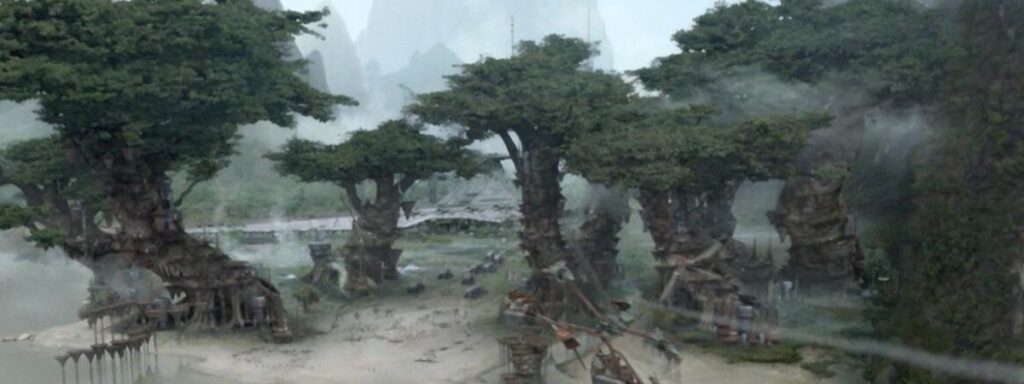
Famous for:
- The lush, forested home world of the Wookiees, including Chewbacca.
- The site of one of the major battles of the Clone Wars.
Appeared in:
- “Star Wars: Episode III – Revenge of the Sith”
Kashyyyk is a verdant planet covered in massive wroshyr trees, where the Wookiees build their homes high above the ground to avoid the dangerous predators below. The Battle of Kashyyyk in “Revenge of the Sith” underscores the planet’s strategic importance and the bravery of its inhabitants, who are crucial allies of the Republic.
Kef Bir
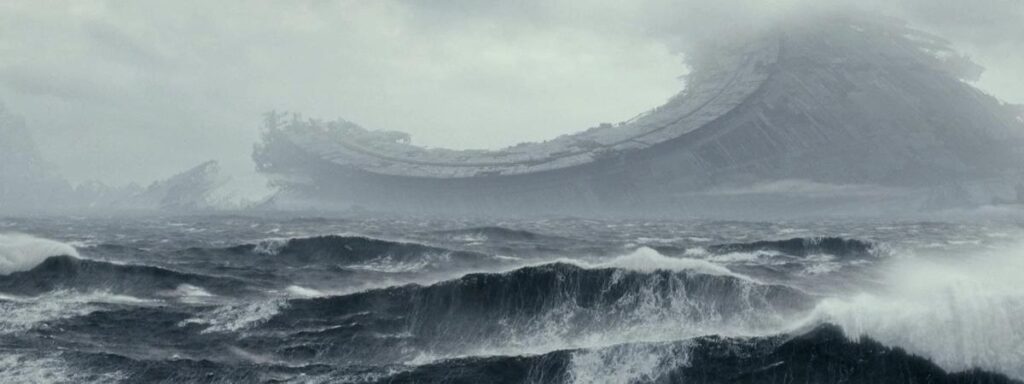
Famous for:
- An ocean moon of the planet Endor.
- The location of the Death Star wreckage in “The Rise of Skywalker.”
Appeared in:
- “Star Wars: Episode IX – The Rise of Skywalker”
Kef Bir is a rugged oceanic world primarily known for the debris of the second Death Star that crashed into its seas after the battle of Endor. This moon’s harsh coastline and turbulent waters serve as the backdrop for pivotal moments in the saga’s conclusion, where secrets of the past are unearthed and the final destiny of the Skywalker lineage is forged.
Kessel

Famous for:
- Its notorious spice mines.
- A key location in the Kessel Run, a smuggler’s route made famous by Han Solo.
Appeared in:
- “Solo: A Star Wars Story”
- “Star Wars: Episode IV – A New Hope” (mentioned)
Kessel is a planet synonymous with peril and exploitation. Its spice mines feature harsh working conditions, where prisoners and slaves are forced to labor. The planet’s grim reality contrasts with its importance in smuggling lore, providing a critical test of skill and speed through the dangerous hyperspace route known as the Kessel Run.
Lothal

Famous for:
- A key site in the early rebellion against the Empire.
- The home planet of Ezra Bridger in “Star Wars Rebels.”
Appeared in:
- “Star Wars Rebels”
Lothal is a planet with significant Imperial interest, particularly its resources and strategic location. It becomes a central setting in “Star Wars Rebels,” where a small group of rebels’ grassroots efforts begin to challenge the Empire’s might. Lothal’s story is of resistance and hope, as its native son, Ezra Bridger, rises to become a key figure in the burgeoning Rebel Alliance.
Malachor

Famous for:
- A dark, desolate world associated with ancient Sith lore.
- The site of a significant battle involving Jedi and Sith, known for its catastrophic outcome.
Appeared in:
- “Star Wars Rebels”
Malachor is a grim reminder of the fierce battles between Jedi and Sith, featuring ruins and a battlefield scarred by a superweapon. It’s a planet steeped in the dark side of the Force, where Sith secrets and dangerous artifacts lie buried, often sought after for their power and peril.
Maldo Kreis

Famous for:
- An ice-covered planet featured in the opening of “The Mandalorian.”
- The location where the Mandalorian first captures the mythrol.
Appeared in:
- “The Mandalorian”
Maldo Kreis is a frozen, inhospitable planet seen in “The Mandalorian,” where the harsh conditions match the rugged survival skills of the bounty hunter known as Mando. This remote icy world is a fitting backdrop for the gritty, tense scenes that set the tone for the series’ adventures.
Mandalore
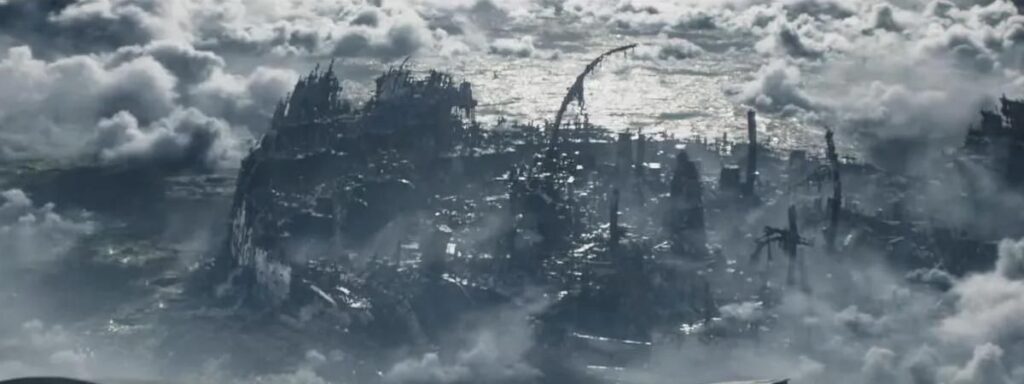
Famous for:
- The homeworld of the Mandalorians, a warrior culture known throughout the galaxy.
- Central to the plotlines involving political intrigue and warfare in “The Clone Wars” and “Star Wars Rebels.”
Appeared in:
- “Star Wars: The Clone Wars”
- “Star Wars Rebels”
Mandalore is a planet with a rich history of conflict and strength. Due to its influential warrior culture, it is often at the center of galactic politics. Its surface is marked by large, desolate, war-torn areas, reflecting the intense battles that have shaped its history. Mandalore’s complex society and the struggle for its control are pivotal to understanding the broader conflicts within the Star Wars saga.
Mon Cala
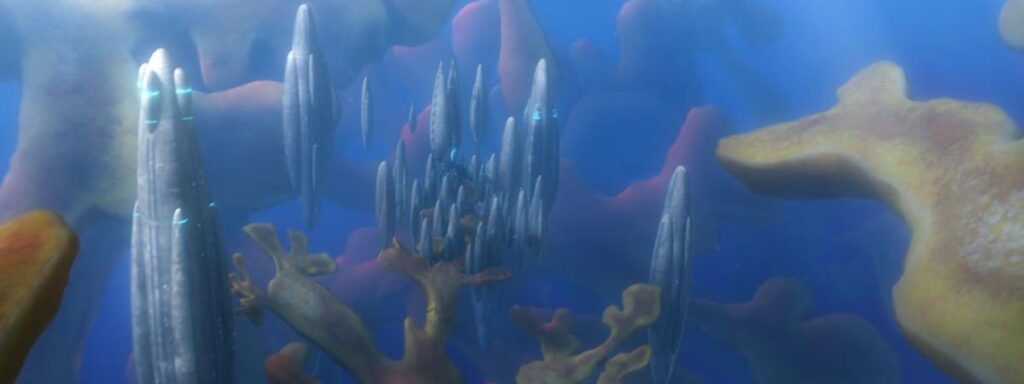
Famous for:
- An oceanic planet home to the Mon Calamari and Quarren species.
- Known for its shipbuilding capabilities, producing vessels used by the Rebel Alliance.
Appeared in:
- “Star Wars: The Clone Wars”
Mon Cala is a beautiful, water-covered world where vast cities are submerged beneath the waves. It is inhabited by the technologically advanced Mon Calamari and the industrious Quarren. The planet is crucial for producing starships that significantly aid the Rebel Alliance’s efforts. It also served as a battleground during the Clone Wars, highlighting its strategic importance and the resilience of its people.
Moraband
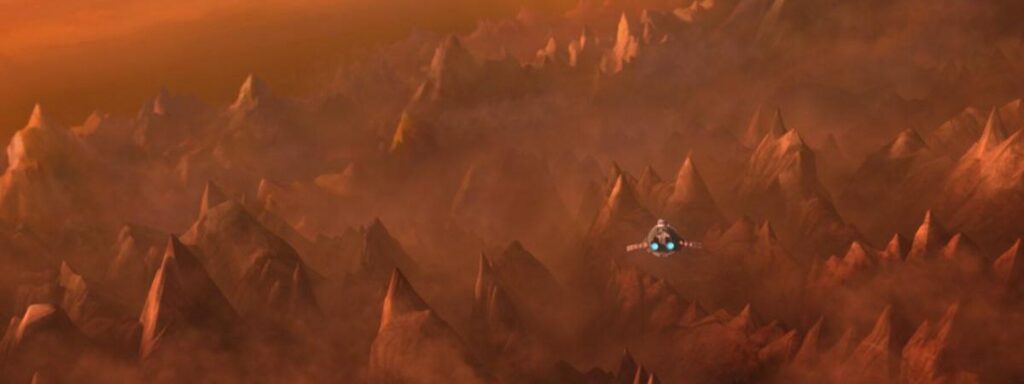
Famous for:
- Also known as Korriban, it is the ancient homeworld of the Sith.
- Known for its dark side energy and ancient Sith tombs.
Appeared in:
- “Star Wars: The Clone Wars” animated series
Moraband, formerly known as Korriban in ancient times, is a desolate and eerie planet, filled with the ruins of temples and tombs of the Sith Lords. It is a place of great dark side power and significant archaeological importance, often visited by those seeking to understand the deepest secrets of the Sith.
Mortis
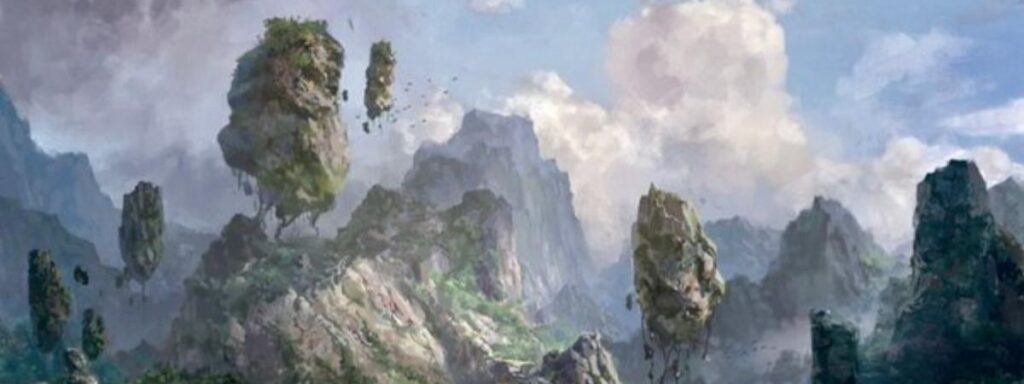
Famous for:
- A mystical realm that exists outside of the normal space-time continuum.
- Home to the Ones, a trio of powerful Force wielders who represent different aspects of the Force.
Appeared in:
- “Star Wars: The Clone Wars” animated series
Mortis is an ethereal place in the Star Wars lore, symbolizing the spiritual heart of the Force. It serves as the setting for pivotal moments in “The Clone Wars,” where Anakin Skywalker, Obi-Wan Kenobi, and Ahsoka Tano face trials that challenge their deepest beliefs about the Force and themselves. Mortis represents a metaphysical dimension where the boundaries of time and space are blurred.
Mustafar

Famous for:
- The volcanic planet where Obi-Wan Kenobi and Anakin Skywalker have their tragic duel.
- The site of Darth Vader’s fortress.
Appeared in:
- “Star Wars: Episode III – Revenge of the Sith”
- “Rogue One: A Star Wars Story”
Mustafar is a fiery, hellish world known for its rivers of lava and harsh landscapes, making it a symbol of destruction and pain in the Star Wars saga. The duel on Mustafar between Anakin and Obi-Wan is one of the most iconic battles in the series, representing Anakin’s final transformation into Darth Vader. Vader’s fortress later becomes a place of dark side power and personal reflection for the Sith Lord.
Naboo

Famous for:
- The lush, peaceful planet that is the home of Queen Amidala and Emperor Palpatine.
- The site of important events in the prequel trilogy, including the Battle of Naboo.
Appeared in:
- “Star Wars: Episode I – The Phantom Menace”
- “Star Wars: Episode II – Attack of the Clones”
- “Star Wars: Episode III – Revenge of the Sith”
Naboo is known for its stunning landscapes, from rolling plains and swamps to underwater cities inhabited by the Gungans. As the starting point for both Queen Amidala and Emperor Palpatine, it plays a central role in the political and military events that shape the galaxy. Naboo is emblematic of the saga’s recurring themes of democracy, leadership, and conflict.
Nal Hutta

Famous for:
- Known as the “Glorious Jewel” in Huttese, it is the homeworld of the Hutt species.
- A hub of crime and corruption within the galaxy.
Appeared in:
- “Star Wars: The Clone Wars” animated series
Nal Hutta is a swampy, polluted planet that serves as the capital of Hutt Space, renowned for its lawlessness and as a sanctuary for criminals across the galaxy. The planet’s environment is as murky as its dealings, with its ruling Hutt clans involved in various illicit activities, making it a frequent backdrop for underworld plots in the Star Wars saga.
Nevarro

Famous for:
- A volcanic planet featured in “The Mandalorian.”
- The location of the Bounty Hunters’ Guild’s last operating base.
Appeared in:
- “The Mandalorian”
Nevarro is a frontier world at the edge of the galaxy, characterized by its rocky terrain and molten lava flows. It plays a central role in “The Mandalorian,” as the setting for several key events, including intense battles and pivotal turning points for the series’ characters. The planet’s rough landscape mirrors the harsh, often precarious life of its inhabitants, especially the bounty hunters and remnants of the Empire.
Pasaana
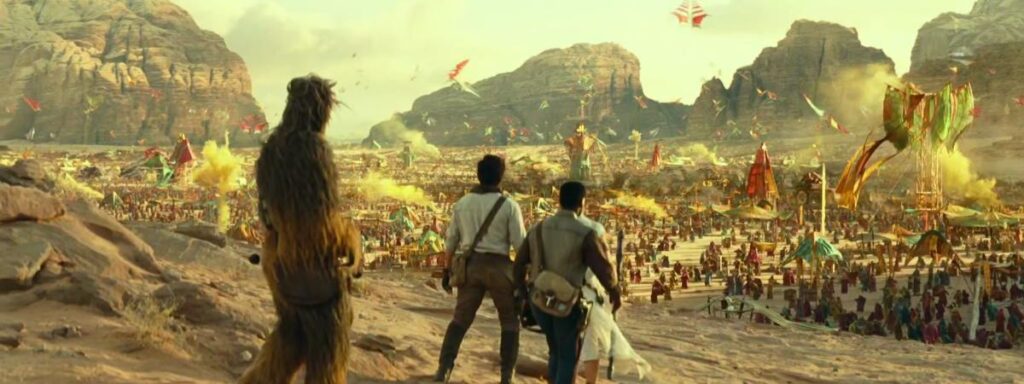
Famous for:
- A desert planet where the Resistance discovers clues leading to Exegol.
- The site of the Festival of the Ancestors.
Appeared in:
- “Star Wars: Episode IX – The Rise of Skywalker”
Pasaana is a remote desert world, featuring sweeping dunes and rocky canyons. Its relatively obscure status in the galaxy changes when it becomes a key location in the search for the Sith wayfinder. The planet’s vibrant, colorful Festival of the Ancestors provides a rich cultural backdrop against which the protagonists navigate their quests and confrontations.
Peridea
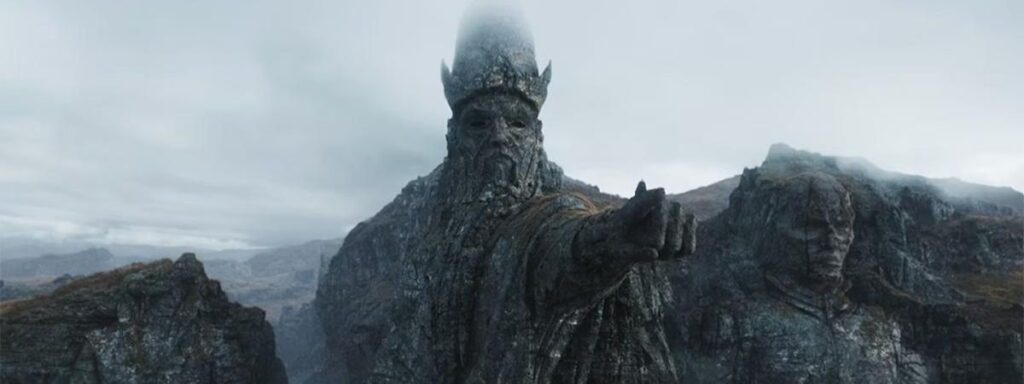
Famous for:
- An extragalactic planet located in the Far galaxy, beyond the known reaches of the Star Wars universe.
- The homeworld of the Noti and the once-mighty Witch Kingdom of the Dathmiri.
- The final destination of Imperial Grand Admiral Thrawn and Jedi Ezra Bridger, banished by a pod of purrgil at the climax of the Liberation of Lothal.
Appeared in:
- “Ahsoka”
Peridea is shrouded in mystery and steeped in the lore of distant, forgotten powers. This remote planet was once the center of the Witch Kingdom of the Dathmiri, a dominion that wielded formidable magic before its eventual collapse. The Arcana Star Map of the Witches of Dathomir shows a Pathway to Peridea, hinting at its significance in ancient times. Notably, it became the exile site for Thrawn and Ezra Bridger, who were sent there by purrgil, enigmatic space-faring creatures whose bones form the planet’s distinctive rings. Peridea’s legends continue to inspire tales among Jedi Younglings, adding a layer of mythic grandeur to its enigmatic presence in the galaxy.
Ryloth
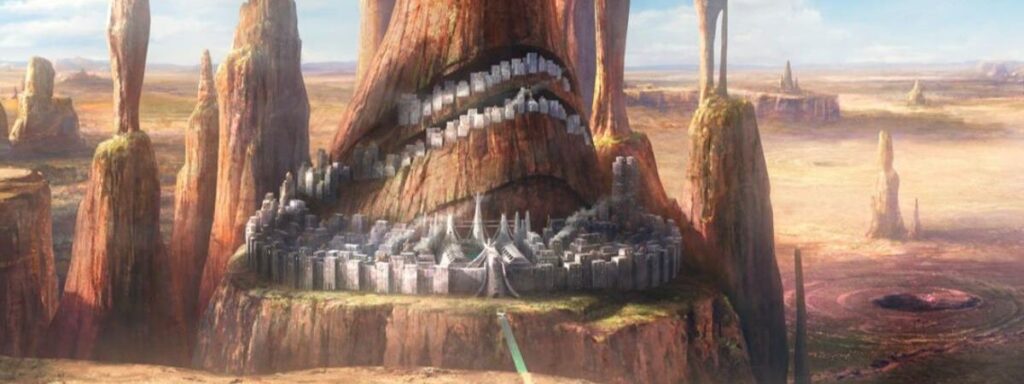
Famous for:
- The homeworld of the Twi’leks, a species known for their distinctive head-tails called lekku.
- A key location in the Galactic Civil War and the fight against the Empire.
Appeared in:
- “Star Wars: The Clone Wars” animated series
- “Star Wars Rebels”
Ryloth is a planet of stark contrasts, featuring harsh, rocky landscapes alongside rich, fertile valleys. It is perpetually half in darkness, due to its tidally locked rotation. The planet’s strategic importance comes from its ryll spice mines, making it a frequent target for exploitation and conflict. Ryloth’s struggles for freedom against various oppressors are a recurring theme in its appearances, showcasing the resilience and spirit of its native Twi’lek inhabitants.
Seatos

Famous for:
- A dark world with vast oceans, rugged terrain, and mysterious red forests.
- Historical home of the ancient Dathomiri, ancestors of Lady Morgan.
Appeared in:
- “Ahsoka”
Seatos combines enigmatic beauty with deep historical significance. Once inhabited by the ancient Dathomiri, this planet features a unique mechanism powered by a star map, revealing pathways to distant galaxies like Peridea. Elements in the “Ahsoka” series hint at connections to the ancient Sith and the purrgil, creatures integral to key galactic events. The study of Seatos is poised to reshape the Star Wars timeline, offering fresh narrative possibilities for the franchise.
Scarif
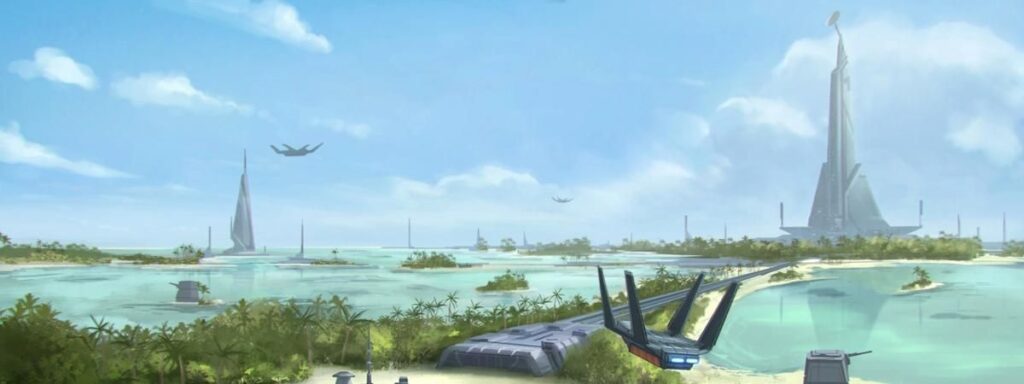
Famous for:
- The tropical planet with an Imperial security complex housing the Death Star plans.
- The site of the pivotal Battle of Scarif, where a group of Rebel fighters launched a desperate assault to steal those plans.
Appeared in:
- “Rogue One: A Star Wars Story”
Scarif is a beautiful but heavily fortified planet, surrounded by a planetary shield and marked by white sandy beaches and turquoise waters. Its idyllic appearance belies the intense battle that takes place on its surface, which ultimately leads to significant Rebel victories but at great cost. Scarif is symbolic of the high stakes and sacrifices involved in the Rebel Alliance’s fight against the Galactic Empire.
Takodana
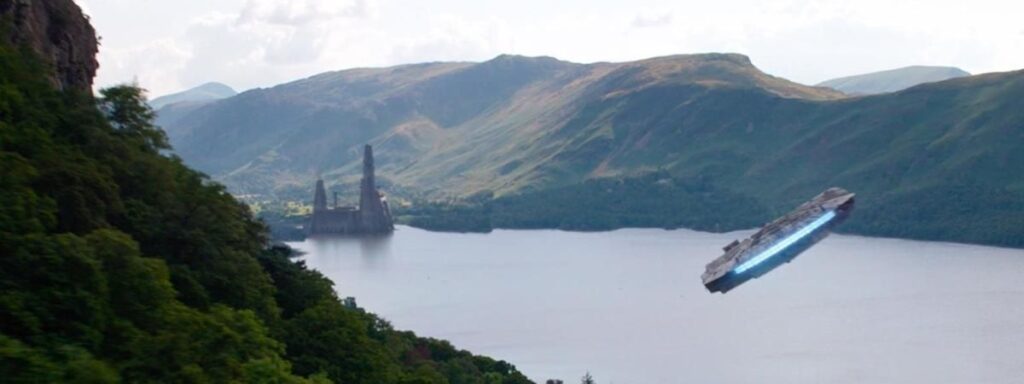
Famous for:
- The lush, forested planet that hosts Maz Kanata’s castle.
- A neutral meeting place for pirates, smugglers, and others from the fringes of the galaxy.
Appeared in:
- “Star Wars: Episode VII – The Force Awakens”
Takodana is renowned for its scenic beauty, featuring dense forests and clear lakes, which belie its role as a haven for those looking to avoid the prying eyes of authority. Maz Kanata’s ancient castle on Takodana serves as a crucial crossroads for the protagonists in “The Force Awakens,” providing them with key alliances and revelations. It symbolizes the galaxy’s complex socio-political landscape, where various factions and characters intersect.
Tatooine
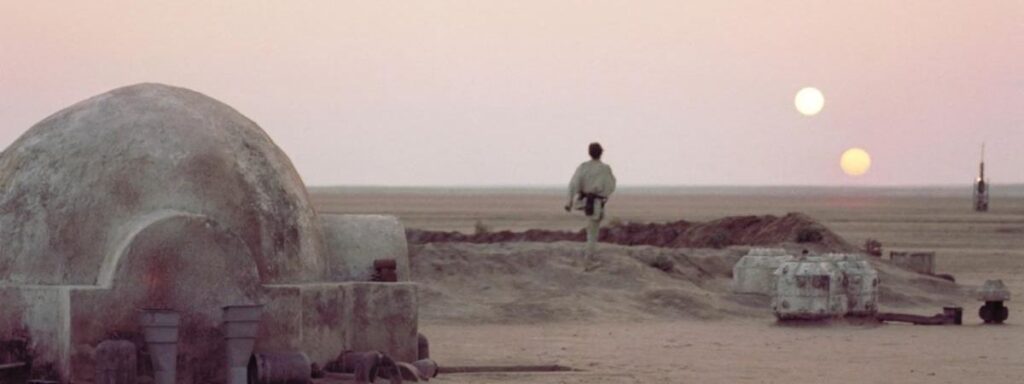
Famous for:
- The harsh desert planet and childhood home of Anakin and Luke Skywalker.
- The infamous locale of Jabba the Hutt’s palace.
- The site of key events like the Boonta Eve Classic Podrace and the purchase of R2-D2 and C-3PO by the Skywalkers.
Appeared in:
- “Star Wars: Episode I – The Phantom Menace”
- “Star Wars: Episode II – Attack of the Clones”
- “Star Wars: Episode III – Revenge of the Sith”
- “Star Wars: Episode IV – A New Hope”
- “Star Wars: Episode VI – Return of the Jedi”
- And various other films and series within the franchise.
Tatooine is a pivotal planet in the Star Wars universe, known for its expansive deserts, treacherous sandstorms, and iconic twin sunsets. It serves as the backdrop for many critical moments in the Skywalker saga, from the humble beginnings of Anakin and Luke Skywalker to significant turning points in the Galactic Civil War. The planet’s rough landscape and resilient inhabitants reflect themes of survival and destiny. Tatooine’s diverse ecosystem, including the dangerous Tusken Raiders and massive Sarlacc pit, adds to its allure and danger, making it a legendary setting within the Star Wars galaxy.
Utapau

Famous for:
- Its distinctive sinkhole cities, where residents live in crater-like depressions.
- The site of General Grievous’s defeat during the Clone Wars.
Appeared in:
- “Star Wars: Episode III – Revenge of the Sith”
Utapau is characterized by its unique geological formations, with large sinkholes housing entire communities within their steep walls. This planet plays a pivotal role in “Revenge of the Sith” as the site of one of the final battles of the Clone Wars, where Obi-Wan Kenobi confronts and defeats General Grievous, marking a significant, albeit short-lived, victory for the Republic.
Yavin

Famous for:
- The gas giant with one of its moons, Yavin 4, serving as the first base of operations for the Rebel Alliance.
- The location of the Rebel’s major victory in the Battle of Yavin, where Luke Skywalker destroys the Death Star.
Appeared in:
- “Star Wars: Episode IV – A New Hope”
Yavin 4 is a jungle-covered moon orbiting the gas giant Yavin in the galaxy’s Outer Rim. Its thick rainforests and ancient massassi temples provide not only a strategic but also a visually striking setting for the Rebel Alliance’s early operations. The Battle of Yavin immortalizes the moon’s historical significance, which sees the destruction of the Death Star and serves as a major turning point in the Galactic Civil War.
As our galactic journey concludes, we’ve traversed the expansive Star Wars universe, visiting planets pivotal to the saga’s rich history and its legendary timeline. Each destination, from the birthplace of the iconic villain Darth Vader to the eerie landscapes of Exegol, has been brought to vivid life through cutting-edge special effects. These celestial bodies have not only entertained but also deepened our understanding of the intricate Star Wars mythology. Whether you’re a long-time fan or a newcomer to the series, these planets provide a deeper insight into the forces that shape the epic narrative.
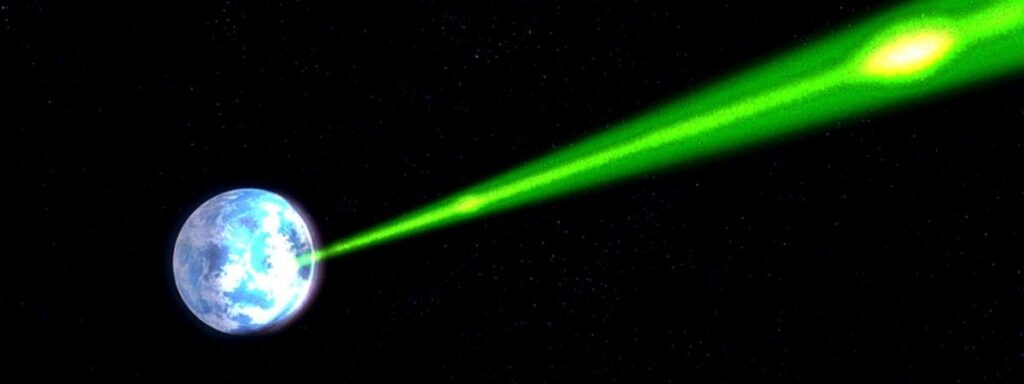
How many planets are in Star Wars?
The Star Wars universe is vast, featuring over 1.3 million distinct planets across its cinematic releases, animated series, books, and games. These range from highly iconic planets like Tatooine and Coruscant to lesser-known worlds introduced in expanded universe materials.
What planets were destroyed in Star Wars?
Several planets have met dramatic ends in the Star Wars saga: Alderaan was famously destroyed by the Death Star as a demonstration of power in “A New Hope”; Hosnian Prime was obliterated by Starkiller Base in “The Force Awakens” to incapacitate the New Republic; and Kijimi was destroyed in “The Rise of Skywalker” by a Star Destroyer equipped with planet-killing weaponry.
What would be the best Star Wars planet to live on?
Naboo stands out as an ideal place to live within the Star Wars universe. Known for its breathtaking landscapes, tranquil lakes, and vibrant cities, Naboo offers a high standard of living, cultural richness, and a peaceful political climate, making it a desirable location for its inhabitants.
Where was Darth Vader born?
Darth Vader, born Anakin Skywalker, originated from Tatooine, a harsh desert planet known for its twin suns and sparse population. This planet’s challenging environment shaped Anakin’s early life before he became the Sith Lord, Darth Vader.
Where was Darth Sidious born?
Darth Sidious, whose birth name is Sheev Palpatine, was born on the lush, culturally rich planet of Naboo. This planet’s significance extends beyond its beauty, as it is also the site of Palpatine’s early political career and rise to power.
Where is Darth Maul from?
Darth Maul is from Dathomir, a remote planet known for its strong connections to the dark side of the Force. Dathomir is home to the Nightsisters, a clan of powerful Force-sensitive witches, and the Zabrak tribes that Maul belongs to.
